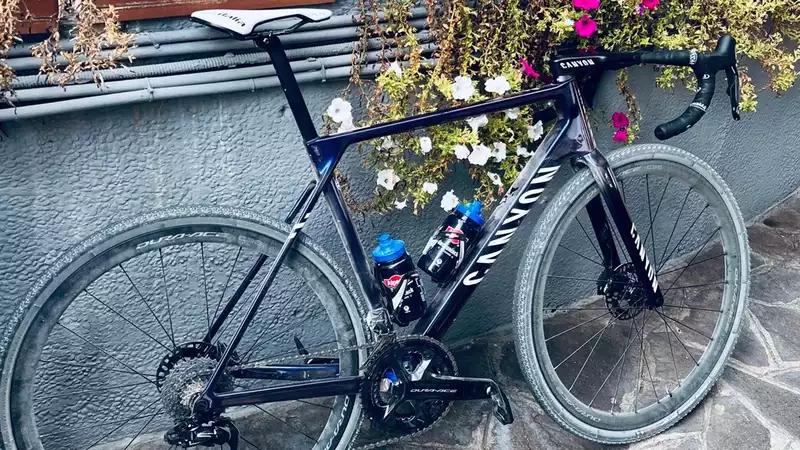This weekend marks the first UCI Gravel World Championships, and despite the ever-increasing number of gravel bikes offered by the world's biggest bike manufacturers, Mathieu Van der Pol will be riding the 194km course on a lightweight semi-aero road bike, Canyon's new Ultimate CFR. He has chosen not to ride his two more gravel-specific bikes, the Grizl and the Grail.
Images of the bike and a video of Van der Poel in pre-race training show that the bike is equipped with Shimano's Dura-Ace groupset and wheels, and not the sponsor's gravel-specific GRX groupset. The handlebars and stem are also made of the same carbon material, and aside from the obvious differences in tire choice, Van der Poel seems to be using his usual road setup, with pedals and shoes for road use as well.
He is not alone. A number of images shared by Specialized confirm that Péter Sagan, Sheena Fry, and Sofia Gomez Villafane will be riding Specialized Roubaix, an endurance-focused road bike designed for and named after the cobbled roads of northern France
The girls are the first to ride the bike this year.
This year's 140km women's and 194km men's races are about 30% asphalt, a little closer to Strade Bianche than to rocky terrain and trials. Since pro cycling is an arms race and no rider wants to feel that they are on a slower bike than their competitors, road bikes with larger volume tires will probably dominate.
Will the categories of fast gravel bikes and high-performance disc road bikes blend into each other, or is this a scenario where speed trumps all and pro riders are willing to sacrifice comfort and increase the risk of breakage to get the fastest bike possible?
Gravel and off-road riding is understandably tough on bikes. Most of us would shy away from putting gravel tires on our best road bikes and riding over rough terrain. Gravel-specific bikes have more clearance for high-capacity tires and wider rims, and more comfortable geometry. Road-specific wheels are slightly narrower on the inside than gravel-specific models, which can be a problem when mounting high-capacity gravel tires. Recall the breakage of carbon wheels at Jumbo Visma and Paris-Roubaix.
However, it is not that uncommon for riders to use road bikes in gravel races; more and more road models are available with 32mm or even 35mm tires, making it easy to fit gravel tires. On the gravel circuit, several professional riders have no problem using road-specific frames. Peter Stetina has used a Canyon Ultimate in gravel races before. Looking back at that particular bike now, it is interesting to see how things have developed in this area.
Also, Sandy Florence used the lightweight Trek Emonda in a similar guise at Super Sweetwater in 2020. A few years ago, Lachlan Morton showed that the Cannondale Super Six Evo can handle it.
Since about 2014, the bicycle industry has focused so much on gravels that it is now hard to find a major brand that does not have at least one in its lineup. But if gravel world championship contenders are riding road bikes, does that mean we can ditch our gravel bikes and ride off-road on road bikes, too?
Probably not. The pros we will see in the races have the best bike handling skills and will easily go over sections where we mere mortals would test our bikes. If they risk taking their road bikes off-road and damage their bikes, they will have expensive repairs.
Nevertheless, a world championship race is a tough test for any equipment, and perhaps proof that modern road bikes are more capable. In a few years, you will be able to do road, gravel, and cyclocross on one bike, with several different tires to choose from.
What we do know is that there will be some very fast bikes on the starting line this weekend at the Gravel World Championships. Will they be overwhelmingly fast, or will the course damage the pure road bikes?
.

Comments